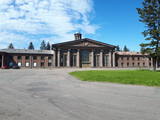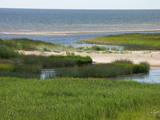| Nr | Nosaukums | Apraksts |
|---|---|---|
|
Kafejnīca “Kursas zeme” atrodas vecpilsētas centrā – rātslaukumā. Tajā ir divas zāles, kā arī vasaras terase rātslaukuma pusē. Interjers pielāgots senās pilsētas aurai - ar vintage stila lampām un gleznām pie sienām. Kafejnīcas telpās atrodas arī kafijas grauzdētava “Curonia”, tāpēc apmeklētājiem tiek piedāvāta svaiga un garšīga kafija. |
||
|
Opekalns (arī Apukalns, Opekols) ir paugurs Alūksnes augstienē, 235 metrus virs jūras līmeņa, Veclaicenes pauguraines viena no augstākajām virsotnēm. Tā virsotnē uzcelta Opekalna luterāņu baznīca (1774—1779), kas ir visaugstāk virs jūras līmeņa novietotais dievnams Latvijā. Opekalna ciemā dzimis leģendārais Dziesmu svētku virsdiriģents Haralds Mednis. |
||
|
Abavas senlejas kreisā pamatkrasta nogāzē bijušo Firkspedvāles un Briņķpedvāles muižu ēku apkārtnē pēc tēlnieka O. Feldberga ierosmes 1992. gadā izveidots brīvdabas mākslas muzejs parks. Te var iepazīt laikmetīgās mākslas darbus, kā arī piedalīties mākslas simpozijos, radošajās darbnīcas un citos pasākumos.
|
||
|
No vēsturiskā un arhitektoniskā viedokļa – interesants 17. - 19. gs. pilsētbūvniecības piemineklis. Vecliepāja atrodas Vecā tirgus un Kuršu laukuma rajonā, kur no 16. gs. 60. gadiem notikusi tirdzniecība. Līdz 1792. g. Kuršu laukums bija arī soda izpildes vieta. 1910. g. tam līdzās izveidoja tagadējo Pētertirgus paviljonu. Palūkojoties kartē redzams, ka ielu tīkls līdz pat mūsdienām ir daļēji saglabājis viduslaiku pilsētu centriem raksturīgo haotiskumu. |
||
|
Atrodas Sakas un Liepājas ielas krustojumā. Ēka, kas šobrīd atrodas sliktā stāvoklī, celta 19. gs. vidū. |
||
|
Ievērojamas ar izlīkumoto Slampes upītes gultni, pateicoties kam, te pamazām atgriežas dabiskām mitrām pļavām un upēm raksturīgās augu un dzīvnieku sugas. Dunduru pļavās ganās dzīvei savvaļā pielāgotie mājlopi, kurus var lieliski vērot no blakus esošā putnu vērošanas torņa. Līdz Dunduru pļavām nokļūstam pa šauru, mežiem ieskautu koridoru - t.s. Melnragu rīkli, cauri kurai izbūvēts grantēts ceļš. Tās galā atrodas paaugstinājums – t.s. Kurgāns, no kura paveras plaša apkārtnes ainava. |
||
|
Jelgavas pils dienvidaustrumu spārna cokolstāvā ir iepazīstamas Kurzemes un Zemgales valdnieku - Ketleru un Bīronu dzimtas kapenes (laika posms no 1569. – 1791. g.), kur apskatāmi 18 restaurētie sarkofāgi. Šī ir Baltijas mērogā nozīmīga vieta, kas noteikti jāapmeklē ikvienam vēstures interesentam. |
||
|
1996. g. atklātais piemineklis (tēlniece: A. Veinbaha) Dagdā (starp Asūnes un Rēzeknes ielām) ir piemiņas vieta komunisma terora upuriem. No šejienes paveras labs skats uz salām bagāto Dagdas ezeru. |
||
|
Spilves pļavas tika izmantotas kara aviācijas vajadzībām jau 1. Pasaules kara laikā. 1922. gadā bumbu sabojātā lidlauka atjaunošanu veica Latvijas Republikas Aviācijas divizions Jāzepa Baško vadībā. Drīz pēc tam Spilvē 51 hektāru lielā teritorijā pie Rīgas - Bolderājas dzelzceļa atzara un šosejas iekārtoja arī civilo lidostu, kuru no Rīgas pilsētas nomāja Latvijas Pasta un telegrāfa departaments. |
||
|
„Ainaži – Salacgrīva” - nozīmīga teritorija rifu aizsardzībai. Teritorija atrodas iepretim Salacgrīvas novadam, tās platība ir 7239 ha.
|
||
|
2005. gadā veidota laipu taka, pa kuru no Duntes muižas (atrodas Minhauzena muzejs) cauri mitrajiem piekrastes mežiem var veikt pārgājienu līdz jūrai. Takas malās izveidotas atpūtas vietas un ar slaveno baronu Minhauzenu saistīti koka tēli un atrakcijas. Atrodas Ziemeļvidzemes biosfēras rezervātā.
|
||
|
Ar dažāda lieluma laukakmeņiem klāts un nelieliem zemesragiem un līčiem izrobots Rīgas līča austrumu krasta posms, kā arī vienīgā vieta Latvijā, kur jūras krastā, posmā starp Tūju un Vitrupes ieteku un dienvidos no Tūrjas jūras viļņu abrazīvās darbības iespaidā izveidojušies līdz dažus metrus augsti smilšakmens atsegumi. Viens no izcilākajiem ir nepilnu puskilometru garās un līdz 4 m augstās Veczemu klintis. To apkārtne ir labiekārtota. Ļoti mainīgs un dinamisks jūras krasta posms, īpaši pēc lielām vētrām!
|
||
|
“Jēru klubs” ir zemnieku saimniecība, kura pamatā nodarbojas ar aitkopību. Iespējams iegādāties bioloģiski tīru un veselīgu jēra gaļu, dziju, aitādas, vaislas materiālu - teķīšus un aitiņas audzēšanai, kā arī aitkopības inventāru - elektriskos žogus ganīšanai aplokos. Jēru klubs ir zemnieku saimniecība Mazsalacā, kas īpaša ar to, ka aitiņas dzīvo īstā klubā! Saimnieki piedāvā piedzīvot lauku saimniecības atmosfēru, kurā galveno lomu spēlē aitas. Baudīt jēra gaļas un aitu piena produktu ēdienus, sajust, cik ērti ir lasīt savu mīļāko grāmatu, sēžot uz pūkainas aitādas un, lai vakarā pie ugunskura nesaltu, iegūt savā īpašumā siltas vilnas zeķes un austus vilnas apmetņus. Saimnieki aicina ģimenes no Latvijas un visas pasaules viesoties ilgāk, nakšņojot jaunajā Glempinga teltī, maksimāli tuvu dabai un veselīgai lauku videi, nezaudējot ne nieka no komforta, ko esam raduši baudīt ikdienā. Ekskursijas laikā saimnieki Ilze un Valters labprāt dalīsies pieredzē par aitu audzēšanu un kopšanu, bet pēc iepriekšējas vienošanās arī pagatavos gardu maltīti no jēra gaļas.Ja ir vēlēšanās, ekskursija Jēru klubā tiek papildināta ar dažādām aktivitātēm - spēlēm, viktorīnu un radošām darbnīcām, izmantojot aitas vilnu. |
||
|
Atrodas Grobiņas nomalē (dienvidaustrumdaļā) pie Liepu gatves (saukti arī par Priediena senkapiem). Arheoloģisko izrakumu rezultāti liecina, ka apbedījumi te skeletkapu, ugunskapu un uzkalniņkapu veidā tapuši laikā no 7. - 9. gs. (atšķirīgi datējumi, arī 4. – 10. gs.) 1987. g. izrakumu laikā te atrada unikālu ar seniem ornamentiem rotātu 8. - 9. gs. skandināvu karavīra kapakmeni (stēlu), kas glabājas Liepājas vēstures un mākslas muzejā un ir vienīgais šāda veida atradums Baltijas jūras dienvidaustrumos. 0,3 km dienvidos no senkapiem lēnām plūst Ālande, kas viduslaikos bijusi kuģojama. Liepas gatves malā uzstādīta informatīva zīme. Grobiņas arheoloģiskais ansamblis ir iekļauts UNESCO Latvijas nacionālajā sarakstā. |
||
|
Tammes dārzniecība ir alternatīvās ražošanas saimniecība, kurā var iepazīties ar ārstniecības augu un garšaugu paraugdārzu. Šeit audzē arī neparastus dārzeņus un kulinārijā izmantojamos dekoratīvos augus. Ja pieteiksieties iepriekš, pēc izglītojošas pastaigas saimniece pacienās ar aromātisku zāļu tēju un pīrādziņiem. Tepat veikalā var nopirkt garšīgus ievārījumus, dārzeņu un garšaugu konservus, garšaugu un drogu maisījumus, kā arī citus savdabīgus produktus. |
||
|
MIKO konditoreja pēc savām īpašajām receptēm gatavo vairāk kā 100 produkcijas veidus - kūkas, pīrāgus, eklērus, cepumus. Sākotnēji tas tika darīts Saldū, bet kopš 2016. gada - arī Liepājā. Visu piedāvāto kopā ar kafiju iespējams nobaudīt nelielajās kafejnīcas telpās, turpat var veikt pasūtījumus, saņemt īpaši gatavotu produkciju un aplūkot mākslinieces Diānas Krūmiņas gleznas. Tiek piedāvāta arī apkalpošana un galdu klāšana banketiem un citiem svinīgiem pasākumiem. |
||
|
Siguldā, Gaujas senlejas kreisā pamatkrasta augšdaļas izvirzījumā starp Paparžu gravu un gravu, pa kuru Gaujas senlejā nolaižas Siguldas – Turaidas ceļš, atrodas Zobenbrāļu ordeņa pils drupas. Pils celtniecību uzsāka 1207. g. Trīs desmitgades vēlāk – 1236. g. pili pārbūvēja Livonijas ordeņa vajadzībām. Siguldas pils stipri cieta karos, kas norisinājās 16. gs. otrajā pusē un 17. gs. sākumā. Ziemeļu kara laikā to nodedzina un vairāk neatjauno. Tagad pilsdrupas ir restaurētas. Aiz pils konventa ēkas dienvidrietumu korpusa un galveno vārtu torņa skatam paveras iekšējā priekšpils, kur izveidota brīvdabas estrāde (notiek ikgadējie Siguldas Opermūzikas svētki un citi publiski pasākumi) un iespaidīgs skats uz Gaujas senleju, Krimuldu un Turaidu. |
||
|
Atrodas Lašos, 0,2 km no Vecumnieku – Ilūkstes ceļa. Sens sēļu pilskalns, kas ir bijis apdzīvots laikā no 1. g. t. pr. Kristus līdz 10. – 12. gadsimtam. Mūsdienās pilskalnā ir redzamas niecīgas atliekas no bijušās Veclašu (Tīzenhauzenu) muižas (iespaidīgais kungu nams bija celts neogotikas stilā, 19. gs. beigās) kompleksa paliekas, no kurām saglabājušās saimniecības ēka, muižas pils pamati, vārtu fragmenti un parks. Līdz 1920. gadam muiža piederēja grāfu Pšezdzecku dzimtai (pirms tam – Tīzenhauzeniem, Fītinghofiem). Pirms dodieties uz šo vietu, tīmeklī ir jāsameklē senie kungu nama fotoattēli. Diemžēl pēdējo 20 gadu laikā šis kultūras piemineklis nav piedzīvojis kādus nozīmīgus labiekārtošanas darbus.
|
||
|
Pilsētā nebija lielu rūpniecības uzņēmumu, un tās iedzīvotāji
nodarbojās galvenokārt ar amatniecību, tirdzniecību un lauksaimniecību.
Ilūkste tika pilnībā nopostīta 1. pasaules kara laikā un smagi cieta arī
2. pasaules kara laikā. Šodien Ilūkste ir klusa pierobežas mazpilsēta, ko
ieskauj gleznains dabas apvidus. Apskates objekti: bijušā jezuītu klostera ēka
un Ilūkstes katoļu baznīca.
|
||
|
Saaremaa kopš seniem laikiem ir spēcīgas alus darīšanas tradīcijas. Kuressaare, ēkā ar Art Deco elementiem, kur kādreiz ražoja elektrību, šodien darītavā Pöide rāda alus brūvēšanas mākslu – uzzināsiet vairākus noslēpumus, bet atsevišķā telpā varēsiet nogaršot gatavo produktu. |
||

























